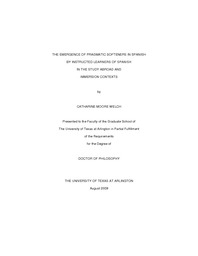
ATTENTION: The works hosted here are being migrated to a new repository that will consolidate resources, improve discoverability, and better show UTA's research impact on the global community. We will update authors as the migration progresses. Please see MavMatrix for more information.
Show simple item record
| dc.contributor.author | Welch, Catharine | en_US |
| dc.date.accessioned | 2009-09-16T18:16:47Z | |
| dc.date.available | 2009-09-16T18:16:47Z | |
| dc.date.issued | 2009-09-16T18:16:47Z | |
| dc.date.submitted | January 2009 | en_US |
| dc.identifier.other | DISS-10200 | en_US |
| dc.identifier.uri | http://hdl.handle.net/10106/1654 | |
| dc.description.abstract | This dissertation explores and expands the term pragmatic softening as produced and perceived by L2 learners of Spanish. The learners included 36 intermediate-level learners studying in a U.S.-based immersion academy and those studying in a study-abroad context in Merida, Mexico. Preliminary evidence from these learners indicates that pragmatic softeners are rightly included in Anderson and Shirai's (1996) theory as a marginal member of the PAST category that is acquired after the more central member--the deictic past--has been acquired. Additionally, it is argued that the term pragmatic softening itself needs to be fleshed out so that it, too, is divided into its subcomponents just as the deictic past is broken down. Based on the data in this study, it is also suggested that among these subcomponents would exist some sort of an acquisitional sequence of the seven PAST pragmatic softeners, since they are acquired at different rates and times. This dissertation also explores whether grammatical competency and prescriptive knowledege (as measured by production of the conditional and past subjunctive) had any bearing on the production of pragmatic softeners. It is determined that the students who answered prescriptive knowledge questions correctly were more likely to also produce pragmatic softeners. Some clear trends are observed in learner perception of pragmatic softener appropriateness, as well. Some of these trends, however, are not congruent with native speaker evaluations. Finally, the question of whether language-learning context shaped pragmatic softener acquisition is addressed. It is determined that the immersion students were more likely to fluctuate in their production of and attitude towards pragmatic softeners than the study abroad group. The immersion group was also more likely to use other mitigating devices on the oral task. | en_US |
| dc.description.sponsorship | Stvan, Laurel Smith | en_US |
| dc.language.iso | EN | en_US |
| dc.publisher | Linguistics | en_US |
| dc.title | The Emergence Of Pragmatic Softeners In Spanish By Instructed Learners Of Spanish In The Study Abroad And Immersion Contexts | en_US |
| dc.type | Ph.D. | en_US |
| dc.contributor.committeeChair | Stvan, Laurel Smith | en_US |
| dc.degree.department | Linguistics | en_US |
| dc.degree.discipline | Linguistics | en_US |
| dc.degree.grantor | University of Texas at Arlington | en_US |
| dc.degree.level | doctoral | en_US |
| dc.degree.name | Ph.D. | en_US |
| dc.identifier.externalLink | https://www.uta.edu/ra/real/editprofile.php?onlyview=1&pid=1558 | |
| dc.identifier.externalLinkDescription | Link to Research Profiles | |
Files in this item
- Name:
- Welch_uta_2502D_10200.pdf
- Size:
- 2.877Mb
- Format:
- PDF
This item appears in the following Collection(s)
Show simple item record


